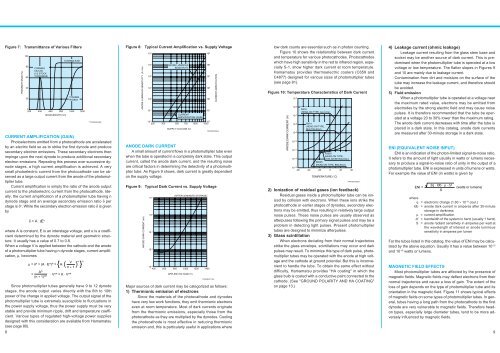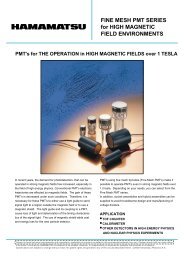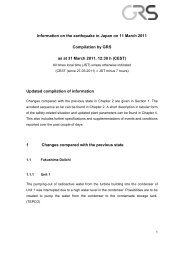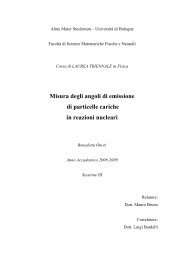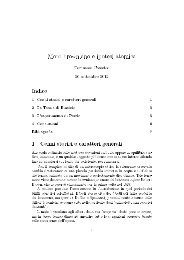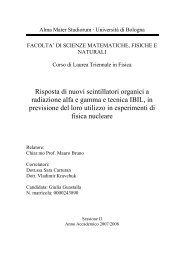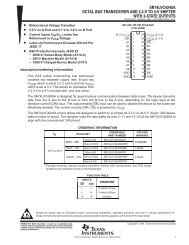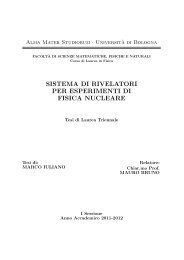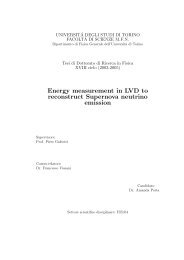Photomultiplier Tubes
Photomultiplier Tubes
Photomultiplier Tubes
You also want an ePaper? Increase the reach of your titles
YUMPU automatically turns print PDFs into web optimized ePapers that Google loves.
PHOTOMULTIPLIER TUBES<br />
Construction and Operating Characteristics<br />
INTRODUCTION<br />
Among the photosensitive devices in use today, the photomultiplier<br />
tube (or PMT) is a versatile device that provides extremely<br />
high sensitivity and ultra-fast response. A typical photomultiplier<br />
tube consists of a photoemissive cathode (photocathode)<br />
followed by focusing electrodes, an electron multiplier and<br />
an electron collector (anode) in a vacuum tube, as shown in Figure<br />
1.<br />
When light enters the photocathode, the photocathode emits<br />
photoelectrons into the vacuum. These photoelectrons are then<br />
directed by the focusing electrode voltages towards the electron<br />
multiplier where electrons are multiplied by the process of secondary<br />
emission. The multiplied electrons are collected by the<br />
anode as an output signal.<br />
Because of secondary-emission multiplication, photomultiplier<br />
tubes provide extremely high sensitivity and exceptionally<br />
low noise among the photosensitive devices currently used to<br />
detect radiant energy in the ultraviolet, visible, and near infrared<br />
regions. The photomultiplier tube also features fast time response,<br />
low noise and a choice of large photosensitive areas.<br />
This section describes the prime features of photomultiplier<br />
tube construction and basic operating characteristics.<br />
Figures 1: Cross-Section of Head-On Type PMT<br />
DIRECTION OF LIGHT<br />
FACEPLATE<br />
e -<br />
FOCUSING<br />
ELECTRODE<br />
SECONDARY<br />
ELECTRON<br />
ELECTORON<br />
MULTIPLIER<br />
(DYNODES)<br />
PHOTOCATHODE<br />
LAST DYNODE<br />
VACUUM<br />
-4 (10 Pa)<br />
ANODE<br />
STEM PIN<br />
STEM<br />
Variants of the head-on type having a large-diameter hemispherical<br />
window have been developed for high energy physics<br />
experiments where good angular light acceptability is important.<br />
Figure 2: External Appearance<br />
a) Side-On Type b) Head-On Type<br />
PHOTO-<br />
SENSITIVE<br />
AREA<br />
H A M A M A T S U<br />
M A D E IN JA PA N<br />
R928<br />
Figure 3: Types of Photocathode<br />
a) Reflection Mode<br />
REFLECTION MODE<br />
PHOTOCATHODE<br />
DIRECTION OF LIGHT<br />
PHOTOELECTRON<br />
b) Transmission Mode<br />
DIRECTION<br />
OF LIGHT<br />
H A M A M A T S U<br />
M A D E IN JA PA N<br />
R 3<br />
TPMSC0028EA TPMOC0083EA<br />
SEMITRANSPARENT<br />
PHOTOCATHODE<br />
PHOTO-<br />
SENSITIVE<br />
AREA<br />
TPMSC0029EA<br />
2) Box-and-grid type<br />
This type consists of a train of quarter cylindrical dynodes<br />
and is widely used in head-on type photomultiplier tubes because<br />
of its relatively simple dynode design and improved<br />
uniformity, although time response may be too slow in some<br />
applications.<br />
TPMOC0078EA<br />
3) Linear-focused type<br />
The linear-focused type features extremely fast response<br />
time and is widely used in head-on type photomultiplier tubes<br />
where time resolution and pulse linearity are important.<br />
TPMOC0079EA<br />
4) Venetian blind type<br />
The venetian blind type has a large dynode area and is<br />
primarily used for tubes with large photocathode areas. It offers<br />
better uniformity and a larger pulse output current. This<br />
structure is usually used when time response is not a prime<br />
consideration.<br />
TPMOC0080EA<br />
6) Microchannel plate (MCP)<br />
The MCP is a thin disk consisting of millions of micro<br />
glass tubes (channels) fused in parallel with each other. Each<br />
channel acts as an independent electron multiplier. The MCP<br />
offers much faster time response than the other discrete dynodes.<br />
It also features good immunity from magnetic fields<br />
and two-dimensional detection ability when multiple anodes<br />
are used. (See pages 60 and 61 for MCP-PMTs.)<br />
TPMOC0082EA<br />
7) Metal channel type<br />
The Metal channel dynode has a compact dynode<br />
costruction manufactured by our unique fine machining technique.<br />
It achieves high speed response due to its narrower<br />
space between each stage of dynodes than the other type of<br />
conventional dynode construction.<br />
It is also adequate for position sensitive measurement.<br />
PHOTOELECTRON<br />
5) Mesh type<br />
In addition, hybrid dynodes combining two of the above dynodes<br />
are available. These hybrid dynodes are designed to<br />
TPMHC0084EB<br />
The mesh type has a structure of fine mesh electrodes<br />
provide the merits of each dynode.<br />
TPMHC0006EA<br />
stacked in close proximity. This type provides high immunity<br />
CONSTRUCTION<br />
The photomultiplier tube generally has a photocathode in either<br />
a side-on or a head-on configuration. The side-on type receives<br />
incident light through the side of the glass bulb, while in<br />
the head-on type, it is received through the end of the glass bulb.<br />
In general, the side-on type photomultiplier tube is relatively low<br />
priced and widely used for spectrophotometers and general photometric<br />
systems. Most of the side-on types employ an opaque<br />
photocathode (reflection-mode photocathode) and a circularcage<br />
structure electron multiplier which has good sensitivity and<br />
high amplification at a relatively low supply voltage.<br />
The head-on type (or the end-on type) has a semitransparent<br />
photocathode (transmission-mode photocathode) deposited<br />
ELECTRON MULTIPLIER<br />
The superior sensitivity (high current amplification and high<br />
S/N ratio) of photomultiplier tubes is due to the use of a low-noise<br />
electron multiplier which amplifies electrons by a cascade secondary<br />
electron emission process. The electron multiplier consists<br />
of from 8, up to 19 stages of electrodes called dynodes.<br />
There are several principal types in use today.<br />
1) Circular-cage type<br />
The circular-cage is generally used for the side-on type of<br />
photomultiplier tube. The prime features of the circular-cage<br />
are compactness and fast time response.<br />
to magnetic fields, as well as good uniformity and high pulse<br />
linearity. In addition, it has position-sensitive capability when<br />
used with cross-wire anodes or multiple anodes. (See pages<br />
58 and 59.)<br />
ELECTRON<br />
ELECTRON<br />
ELECTRON<br />
SPECTRAL RESPONSE<br />
The photocathode of a photomultiplier tube converts energy<br />
of incident light into photoelectrons. The conversion efficiency<br />
(photocathode sensitivity) varies with the wavelength of the incident<br />
light. This relationship between photocathode sensitivity<br />
and wavelength is called the spectral response characteristic.<br />
Figure 4 shows the typical spectral response of a bialkali photomultiplier<br />
tube. The spectral response characteristics are determined<br />
on the long wavelength side by the photocathode material<br />
and on the short wavelength side by the window material. Typical<br />
spectral response characteristics for various types of photomultiplier<br />
tubes are shown on pages 88 and 89. In this catalog,<br />
the longwavelength cut-off of spectral response characteristics<br />
upon the inner surface of the entrance window. The head-on<br />
is defined as the wavelength at which the cathode radiant sensi-<br />
type provides better spatial uniformity (see page 10) than the<br />
tivity becomes 1% of the maximum sensitivity for bialkali and Agside-on<br />
type having a reflection-mode photocathode. Other fea-<br />
O-Cs photocathodes, and 0.1% of the maximum sensitivity for<br />
tures of head-on types include a choice of photosensitive areas<br />
multialkali photocathodes.<br />
from tens of square millimeters to hundreds of square centime-<br />
COARSE MESH TYPE<br />
FINE-MESH TYPE<br />
Spectral response characteristics shown at the end of this<br />
ters.<br />
TPMOC0077EB<br />
catalog are typical curves for representative tube types. Actual<br />
TPMOC0081EA<br />
data may be different from type to type.<br />
4 5<br />
ELECTRON<br />
TPMOC0084EA


